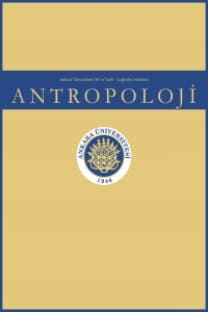Tıp Fakültesi Öğrencilerinde Kraniofasiyal Antropometrik Ölçümlerin Cinsiyete Bağlı Karşılaştırmalı İncelenmesi
Antropometri, Kraniyofasiyal Ölçümler, Vücut Kitle İndeksi, Baş ve Yüz Ölçümleri
Sex Based Comparative Examination of Craniofacial Anthropometric Measurements in Medical School Students
___
- Cattoni, D. M., ve Fernandes, F. (2009). Anthropometric orofacial measurements of children from Sao Paulo and from North America: comparative study. Pro-fono: revista de atualizacao cientifica, 21(1), 25-29. http://doi.org/10.1590/S0104-56872009000100005
- Charles, O., Hakeem, F., Nerwey, D., ve Mildred, B. (2008). Normal Outer and Inner Canthal Measurements of Ijaws of Southern Nigeria. European Journal of Scientific Research, 22, 163-167.
- Farkas, L. G., Posnick, J. C., ve Hreczko, T. M. (1992a). Anthropometric growth study of the head. The Cleft Palate-Craniofacial Journal, 29(4), 303-308. https://doi.org/10.1597/1545-1569_1992_029_0303_agsoth_2.3.co_2
- Farkas, L. G., Posnick, J. C., ve Hreczko, T. M. (1992b). Growth patterns of the face: a morphometric study. The Cleft Palate-Craniofacial Journal, 29(4), 308-314. https://doi.org/10.1597/1545-1569_1992_029_0308_gpotfa_2.3.co_2
- Farkas, L. G. (1994). Examination. L. G. Farkas (Ed.) içinde, Anthropometry of the head and face (s. 3-56). Raven Press.
- Farkas, L. G., Posnick, J. C., Hreczko, T. M., ve Pron, G. E. (1992). Growth patterns in the orbital region: a morphometric study. The Cleft Palate-Craniofacial Journal, 29(4), 315-318. https://doi.org/10.1597/1545-1569_1992_029_0315_gpitor_2.3.co_2
- Farkas, L. G., Posnick, J. C., Hreczko, T. M., ve Pron, G. E. (1992). Growth patterns of the nasolabial region: a morphometric study. The Cleft Palate-Craniofacial Journal, 29(4), 318-324. https://doi.org/10.1597/1545-1569_1992_029_0318_gpotnr_2.3.co_2
- Farkas, L. G., Katic, M. J., ve Forrest, C. R. (2002). Age-related changes in anthropometric measurements in the craniofacial regions and in height in Down’s syndrome. The Journal of Craniofacial Surgery, 13(5), 614-622. https://doi.org/10.1097/00001665-200209000-00004
- Farkas, L. G., Katic, M. J., ve Forrest, C. R. (2007). Comparison of craniofacial measurements of young adult African-American and North American white males and females. Annals of Plastic Surgery, 59(6), 692-698. https://doi.org/10.1097/01.sap.0000258954.55068.b4
- Farkas, L. G., Katic, M. J., Forrest, C. R. (2005). International anthropometric study of facial morphology in various ethnic groups/races. The Journal of Craniofacial Surgery, 16(4), 615-646. https://doi.org/10.1097/01.scs.0000171847.58031.9e
- Farkas, L. G., Katic, M. J., Forrest, C. R., ve Litsas, L. (2001). Surface anatomy of the face in Down’s syndrome: linear and angular measurements in the craniofacial regions. The Journal of Craniofacial Surgery, 12(4), 373-379; discussion 380. https://doi.org/10.1097/00001665-200107000-00011
- Golalipour, M. J. (2006). The effect of ethnic factor on cephalic index in 17-20 years old females of north of Iran. International Journal of Morphology, 24(3), 319-322. https://doi.org/10.4067/S0717-95022006000400004
- Johannsdottir, B., Thordarson, A., ve Magnusson, T. E. (1999). Craniofacial morphology in 6-year-old Icelandic children. European Journal of Orthodontics, 21(3), 283-290. https://doi.org/10.1093/ejo/21.3.283
- Malas, M. A., Sulak, O., Aler, A., ve Öktem, F. (1998). Prematüre yenidoğanlarda kranyofasiyal morfoloji. SDÜ Tıp Fakültesi Dergisi, 5(1), 25-31.
- Nagle, E., Teibe, U., ve Kažoka, D. (2005). Craniofacial anthropometry in a group of healthy Latvian residents. Acta Medica Lituanica, 12, 47-53.
- Ngeow, W. C., ve Aljunid, S. (2009). Craniofacial anthropometric norms of Malays. Singapore Medical Journal, 50, 525-528.
- Ögetürk, M. (1998). Şizofrenik hastalarda baş ve yüz antropometrik ölçümleri. Yayımlanmamış Doktora Tezi. Fırat Üniversitesi, Elazığ.
- Özdemir, M. B., Ilgaz, A., Dilek, A., Ayten, H., ve Esat, A. (2007). Describing normal variations of head and face by using standard measurement and craniofacial variability index (CVI) in seven-year-old normal children. The Journal of Craniofacial Surgery, 18(3), 470-474. https://doi.org/10.1097/01.scs.0000265717.53414.3f
- Şehla, İ. (2006). 9-72 aylık çocuklarda antropometrik ölçümler ve antropometrik ölçümlere etki eden parametrelerin araştırılması. Uzmanlık Tezi. T. C. Sağlık Bakanlığı Bakırköy Dr. Sadi Konuk Eğitim ve Araştırma Hastanesi, İstanbul.
- Thordarson, A., Johannsdottir, B., ve Magnusson, T. E. (2006). Craniofacial changes in Icelandic children between 6 and 16 years of age - a longitudinal study. European Journal of Orthodontics, 28(2), 152-165. https://doi.org/10.1093/ejo/cji084
- Umar, M., Singh, R., ve Shugaba, A. (2006). Cephalometric Indicies among Nigerians. Journal of Applied Sciences, 6(4), 939-942. https://doi.org/10.3923/jas.2006.939.942
- Zankl, A., Molinari, L. (2003). ABase—A tool for the rapid assessment of anthropometric measurements on handheld computers. American Journal of Medical Genetics Part A, 121A(2), 146-150. https://doi.org/10.1002/ajmg.a.20185
- ISSN: 0378-2891
- Yayın Aralığı: Yılda 2 Sayı
- Başlangıç: 1963
- Yayıncı: Ankara Üniversitesi Basımevi
Orta Anadolu’nun Doğusunda Bir Topluluk: Kayalıpınar İnsanları
Bitrokanterik Çap Mesafesi Genç Yetişkin Erkeklerin Flamingo Denge Testi Sonuçlarını Etkiler Mi?
Seda SERTEL MEYVACI, Handan ANKARALI
6-17 Yaş Arası Ankara Çocuk ve Adölesanlarında Büyüme Durumunun Değerlendirilmesi
Başak KOCA ÖZER, Ayşegül ÖZDEMİR, Sibel ÖNAL, Cansev MEŞE YAVUZ
Müslümantepe (Diyarbakır) Orta Çağ Yerleşiminde Yaşam Uzunluğu
Popülerleşen Deyişlerde Anlamı Yakalama ve Doğasına Dokunma Tartışmaları
Murat AKKUŞ, Ceren AKSOY SUGİYAMA
Ahmet İhsan AYTEK, Alper Yener YAVUZ, Orhan Gazi ÖZBEY, Evren ŞAHİN
Osmanlı Devleti’nde Deliler ile Lehistan Askerleri Hussarlar’ın Giyim-Kuşamlarının İncelenmesi
Çevreden Kaynaklanan Göçün Boyutu: Gelişmiş ve Gelişmekte Olan Ülkeler Üzerine Bir Çalışma
